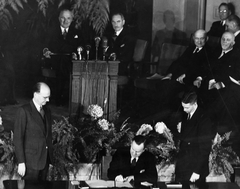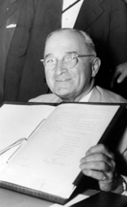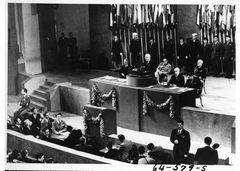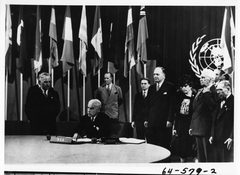This collection focuses on the creation of and United States participation in the North Atlantic Treaty Organization. The collection includes documents covering the years 1948 through 1952. Supporting materials include photographs, oral history transcripts, a chronology of events and other links.
The Development of the North Atlantic Treaty Organization (NATO)
Documents
1949
-
North Atlantic Treaty, April 4, 1949 (NAID: 348806325)
Part of:
- recordGroup: General Records of the United States Government, 1778 - 2006 (NAID: 340)
- Series: Treaties, Agreements, and Other International Acts for Which the United States is the Depositary Government, 1943 - 1984 (NAID: 3999997)
- File Unit: 1949 NATO Treaty: Signed Original (NAID: 348806323)
-
Memorandum from James H. Burns to Secretary of Defense Louis Johnson with Attachments, September 1949 (NAID: 313172762)
Part of:
- Collection: President's Secretary's Files (Truman Administration), 1945 - 1960 (NAID: 1205)
- Series: General Files, 1945 - 1953 (NAID: 602190)
- File Unit: North Atlantic Treaty (NAID: 876490)
-
Memorandum from Stanley Woodward to Matthew Connelly, March 28, 1949 (NAID: 313172760)
Part of:
- Collection: President's Secretary's Files (Truman Administration), 1945 - 1960 (NAID: 1205)
- Series: General Files, 1945 - 1953 (NAID: 602190)
- File Unit: North Atlantic Treaty (NAID: 876490)
-
Telegram from Secretary of State Dean Acheson, March 8, 1949 (NAID: 313172755)
Part of:
- Collection: President's Secretary's Files (Truman Administration), 1945 - 1960 (NAID: 1205)
- Series: General Files, 1945 - 1953 (NAID: 602190)
- File Unit: North Atlantic Treaty (NAID: 876490)
-
Telegram from Secretary of State Dean Acheson, March 1949 (NAID: 313172750)
Part of:
- Collection: President's Secretary's Files (Truman Administration), 1945 - 1960 (NAID: 1205)
- Series: General Files, 1945 - 1953 (NAID: 602190)
- File Unit: North Atlantic Treaty (NAID: 876490)
-
Memorandum, Proposed North Atlantic Security Arrangement, January 1949 (NAID: 313172734)
Part of:
- Collection: President's Secretary's Files (Truman Administration), 1945 - 1960 (NAID: 1205)
- Series: General Files, 1945 - 1953 (NAID: 602190)
- File Unit: North Atlantic Treaty (NAID: 876490)
-
Memorandum from Secretary of State Louis Johnson to President Harry S. Truman, December 20, 1949 (NAID: 313172732)
Part of:
- Collection: President's Secretary's Files (Truman Administration), 1945 - 1960 (NAID: 1205)
- Series: General Files, 1945 - 1953 (NAID: 602190)
- File Unit: North Atlantic Treaty (NAID: 876490)
-
Letter from Clark Clifford to William Southern, Jr., September 9, 1949 (NAID: 301669480)
Part of:
- Collection: Clark M. Clifford White House Files (Truman Administration), 1945 - 1951 (NAID: 598548)
- Series: Clark M. Clifford's Subject Files, 1945 - 1951 (NAID: 598550)
- File Unit: North Atlantic Pact: [4 of 5]; North Atlantic Treaty (NAID: 1766723)
-
Press Release, Toast of President Harry S. Truman at the State Dinner for Atlantic Pact Signers, April 4, 1949 (NAID: 301669478)
Part of:
- Collection: Clark M. Clifford White House Files (Truman Administration), 1945 - 1951 (NAID: 598548)
- Series: Clark M. Clifford's Subject Files, 1945 - 1951 (NAID: 598550)
- File Unit: North Atlantic Pact: [4 of 5]; North Atlantic Treaty (NAID: 1766723)
-
Memorandum from Carlisle Humelsine to Matthew Connelly with Attachment, August 23, 1949 (NAID: 296761913)
Part of:
- Collection: Official Files (Truman Administration), 1945 - 1953 (NAID: 1202)
- Series: Official Files, 1945 - 1953 (NAID: 201124)
- File Unit: North Atlantic Treaty, OF 66 (NAID: 725419)
-
Memorandum from Charles I. Bevans with Related Material, July 1949 (NAID: 296761906)
Part of:
- Collection: Official Files (Truman Administration), 1945 - 1953 (NAID: 1202)
- Series: Official Files, 1945 - 1953 (NAID: 201124)
- File Unit: North Atlantic Treaty, OF 66 (NAID: 725419)
-
State Department Press Release, Address of Secretary of State Dean Acheson, March 19, 1949 (NAID: 296761897)
Part of:
- Collection: Official Files (Truman Administration), 1945 - 1953 (NAID: 1202)
- Series: Official Files, 1945 - 1953 (NAID: 201124)
- File Unit: North Atlantic Treaty, OF 66 (NAID: 725419)
-
State Department Press Release, Transcript of Broadcast, March 18, 1949 (NAID: 296761886)
Part of:
- Collection: Official Files (Truman Administration), 1945 - 1953 (NAID: 1202)
- Series: Official Files, 1945 - 1953 (NAID: 201124)
- File Unit: North Atlantic Treaty, OF 66 (NAID: 725419)
-
Memorandum from W. J. McWilliams to William D. Hassett, with Attachment and Related Material, March 1949 (NAID: 296761438)
Part of:
- Collection: Official Files (Truman Administration), 1945 - 1953 (NAID: 1202)
- Series: Official Files, 1945 - 1953 (NAID: 201124)
- File Unit: North Atlantic Treaty - Miscellaneous, OF 66 (NAID: 294901041)
-
Memorandum, State Department Summary of Telegrams, June 22, 1949 (NAID: 201681583)
Part of:
- Collection: Records of the Naval Aide to the President (Truman Administration), 1945 - 1953 (NAID: 561071)
- Series: State Department Briefs Files, 1945 - 1953 (NAID: 561079)
- File Unit: May - August, 1949 (NAID: 1701901)
-
Memorandum, State Department Summary of Telegrams, June 10, 1949 (NAID: 201673364)
Part of:
- Collection: Records of the Naval Aide to the President (Truman Administration), 1945 - 1953 (NAID: 561071)
- Series: State Department Briefs Files, 1945 - 1953 (NAID: 561079)
- File Unit: May - August, 1949 (NAID: 1701901)
-
Memorandum, State Department Summary of Telegrams, June 8, 1949 (NAID: 201673362)
Part of:
- Collection: Records of the Naval Aide to the President (Truman Administration), 1945 - 1953 (NAID: 561071)
- Series: State Department Briefs Files, 1945 - 1953 (NAID: 561079)
- File Unit: May - August, 1949 (NAID: 1701901)
-
Memorandum, State Department Summary of Telegrams, June 7, 1949 (NAID: 201673361)
Part of:
- Collection: Records of the Naval Aide to the President (Truman Administration), 1945 - 1953 (NAID: 561071)
- Series: State Department Briefs Files, 1945 - 1953 (NAID: 561079)
- File Unit: May - August, 1949 (NAID: 1701901)
-
Memorandum, State Department Summary of Telegrams, April 5, 1949 (NAID: 201388504)
Part of:
- Collection: Records of the Naval Aide to the President (Truman Administration), 1945 - 1953 (NAID: 561071)
- Series: State Department Briefs Files, 1945 - 1953 (NAID: 561079)
- File Unit: January - April, 1949 (NAID: 1701900)
-
Memorandum, State Department Summary of Telegrams, March 21, 1949 (NAID: 201384669)
Part of:
- Collection: Records of the Naval Aide to the President (Truman Administration), 1945 - 1953 (NAID: 561071)
- Series: State Department Briefs Files, 1945 - 1953 (NAID: 561079)
- File Unit: January - April, 1949 (NAID: 1701900)
-
Memorandum, State Department Summary of Telegrams, March 15, 1949 (NAID: 201384664)
Part of:
- Collection: Records of the Naval Aide to the President (Truman Administration), 1945 - 1953 (NAID: 561071)
- Series: State Department Briefs Files, 1945 - 1953 (NAID: 561079)
- File Unit: January - April, 1949 (NAID: 1701900)
-
Memorandum, State Department Summary of Telegrams, March 9, 1949 (NAID: 201384656)
Part of:
- Collection: Records of the Naval Aide to the President (Truman Administration), 1945 - 1953 (NAID: 561071)
- Series: State Department Briefs Files, 1945 - 1953 (NAID: 561079)
- File Unit: January - April, 1949 (NAID: 1701900)
-
Memorandum, State Department Summary of Telegrams, March 7, 1949 (NAID: 201384652)
Part of:
- Collection: Records of the Naval Aide to the President (Truman Administration), 1945 - 1953 (NAID: 561071)
- Series: State Department Briefs Files, 1945 - 1953 (NAID: 561079)
- File Unit: January - April, 1949 (NAID: 1701900)
-
Memorandum, State Department Summary of Telegrams, March 2, 1949 (NAID: 201384649)
Part of:
- Collection: Records of the Naval Aide to the President (Truman Administration), 1945 - 1953 (NAID: 561071)
- Series: State Department Briefs Files, 1945 - 1953 (NAID: 561079)
- File Unit: January - April, 1949 (NAID: 1701900)
-
Memorandum, State Department Summary of Telegrams, February 28, 1949 (NAID: 201384647)
Part of:
- Collection: Records of the Naval Aide to the President (Truman Administration), 1945 - 1953 (NAID: 561071)
- Series: State Department Briefs Files, 1945 - 1953 (NAID: 561079)
- File Unit: January - April, 1949 (NAID: 1701900)
-
Memorandum, State Department Summary of Telegrams, February 15, 1949 (NAID: 201384639)
Part of:
- Collection: Records of the Naval Aide to the President (Truman Administration), 1945 - 1953 (NAID: 561071)
- Series: State Department Briefs Files, 1945 - 1953 (NAID: 561079)
- File Unit: January - April, 1949 (NAID: 1701900)
-
Memorandum, State Department Summary of Telegrams, February 3, 1949 (NAID: 201383558)
Part of:
- Collection: Records of the Naval Aide to the President (Truman Administration), 1945 - 1953 (NAID: 561071)
- Series: State Department Briefs Files, 1945 - 1953 (NAID: 561079)
- File Unit: January - April, 1949 (NAID: 1701900)
-
Memorandum, State Department Summary of Telegrams, February 2, 1949 (NAID: 201383557)
Part of:
- Collection: Records of the Naval Aide to the President (Truman Administration), 1945 - 1953 (NAID: 561071)
- Series: State Department Briefs Files, 1945 - 1953 (NAID: 561079)
- File Unit: January - April, 1949 (NAID: 1701900)
-
Memorandum, State Department Summary of Telegrams, January 27, 1949 (NAID: 201383553)
Part of:
- Collection: Records of the Naval Aide to the President (Truman Administration), 1945 - 1953 (NAID: 561071)
- Series: State Department Briefs Files, 1945 - 1953 (NAID: 561079)
- File Unit: January - April, 1949 (NAID: 1701900)
-
Memorandum, State Department Summary of Telegrams, January 10, 1949 (NAID: 201383532)
Part of:
- Collection: Records of the Naval Aide to the President (Truman Administration), 1945 - 1953 (NAID: 561071)
- Series: State Department Briefs Files, 1945 - 1953 (NAID: 561079)
- File Unit: January - April, 1949 (NAID: 1701900)
-
Memorandum, State Department Summary of Telegrams, January 7, 1949 (NAID: 201383531)
Part of:
- Collection: Records of the Naval Aide to the President (Truman Administration), 1945 - 1953 (NAID: 561071)
- Series: State Department Briefs Files, 1945 - 1953 (NAID: 561079)
- File Unit: January - April, 1949 (NAID: 1701900)
-
Memorandum, State Department Summary of Telegrams, January 5, 1949 (NAID: 201260933)
Part of:
- Collection: Records of the Naval Aide to the President (Truman Administration), 1945 - 1953 (NAID: 561071)
- Series: State Department Briefs Files, 1945 - 1953 (NAID: 561079)
- File Unit: January - April, 1949 (NAID: 1701900)
1950
-
Memorandum from Secretary of Defense Louis Johnson to President Harry S. Truman with Attachment, July 1950 (NAID: 313172768)
Part of:
- Collection: President's Secretary's Files (Truman Administration), 1945 - 1960 (NAID: 1205)
- Series: General Files, 1945 - 1953 (NAID: 602190)
- File Unit: North Atlantic Treaty (NAID: 876490)
-
Memorandum from Secretary of Defense Louis Johnson to President Harry S. Truman, August 30, 1950 (NAID: 313172766)
Part of:
- Collection: President's Secretary's Files (Truman Administration), 1945 - 1960 (NAID: 1205)
- Series: General Files, 1945 - 1953 (NAID: 602190)
- File Unit: North Atlantic Treaty (NAID: 876490)
-
Memorandum from Clark Clifford to President Harry S. Truman, January 14, 1950 (NAID: 301669483)
Part of:
- Collection: Clark M. Clifford White House Files (Truman Administration), 1945 - 1951 (NAID: 598548)
- Series: Clark M. Clifford's Subject Files, 1945 - 1951 (NAID: 598550)
- File Unit: North Atlantic Pact: [4 of 5]; North Atlantic Treaty (NAID: 1766723)
-
Memorandum from John Simmons to Matthew Connelly with Related Material (NAID: 296761916)
Part of:
- Collection: Official Files (Truman Administration), 1945 - 1953 (NAID: 1202)
- Series: Official Files, 1945 - 1953 (NAID: 201124)
- File Unit: North Atlantic Treaty Organization, OF 66 (NAID: 725420)
-
Memorandum, State Department Summary of Telegrams, November 20, 1950 (NAID: 202444115)
Part of:
- Collection: Records of the Naval Aide to the President (Truman Administration), 1945 - 1953 (NAID: 561071)
- Series: State Department Briefs Files, 1945 - 1953 (NAID: 561079)
- File Unit: November - December, 1950 (NAID: 1701906)
-
Memorandum, State Department Summary of Telegrams, November 17, 1950 (NAID: 202444113)
Part of:
- Collection: Records of the Naval Aide to the President (Truman Administration), 1945 - 1953 (NAID: 561071)
- Series: State Department Briefs Files, 1945 - 1953 (NAID: 561079)
- File Unit: November - December, 1950 (NAID: 1701906)
-
Memorandum, State Department Summary of Telegrams, November 10, 1950 (NAID: 202444094)
Part of:
- Collection: Records of the Naval Aide to the President (Truman Administration), 1945 - 1953 (NAID: 561071)
- Series: State Department Briefs Files, 1945 - 1953 (NAID: 561079)
- File Unit: November - December, 1950 (NAID: 1701906)
-
Memorandum, State Department Summary of Telegrams, October 31, 1950 (NAID: 202444086)
Part of:
- Collection: Records of the Naval Aide to the President (Truman Administration), 1945 - 1953 (NAID: 561071)
- Series: State Department Briefs Files, 1945 - 1953 (NAID: 561079)
- File Unit: August - October, 1950 (NAID: 1701905)
-
Memorandum, State Department Summary of Telegrams, September 27, 1950 (NAID: 202440522)
Part of:
- Collection: Records of the Naval Aide to the President (Truman Administration), 1945 - 1953 (NAID: 561071)
- Series: State Department Briefs Files, 1945 - 1953 (NAID: 561079)
- File Unit: August - October, 1950 (NAID: 1701905)
-
Memorandum, State Department Summary of Telegrams, September 19, 1950 (NAID: 202289552)
Part of:
- Collection: Records of the Naval Aide to the President (Truman Administration), 1945 - 1953 (NAID: 561071)
- Series: State Department Briefs Files, 1945 - 1953 (NAID: 561079)
- File Unit: August - October, 1950 (NAID: 1701905)
-
Memorandum, State Department Summary of Telegrams, September 18, 1950 (NAID: 202289551)
Part of:
- Collection: Records of the Naval Aide to the President (Truman Administration), 1945 - 1953 (NAID: 561071)
- Series: State Department Briefs Files, 1945 - 1953 (NAID: 561079)
- File Unit: August - October, 1950 (NAID: 1701905)
-
Memorandum, State Department Summary of Telegrams, August 2, 1950 (NAID: 201944765)
Part of:
- Collection: Records of the Naval Aide to the President (Truman Administration), 1945 - 1953 (NAID: 561071)
- Series: State Department Briefs Files, 1945 - 1953 (NAID: 561079)
- File Unit: August - October, 1950 (NAID: 1701905)
-
Memorandum, State Department Summary of Telegrams, July 31, 1950 (NAID: 201944763)
Part of:
- Collection: Records of the Naval Aide to the President (Truman Administration), 1945 - 1953 (NAID: 561071)
- Series: State Department Briefs Files, 1945 - 1953 (NAID: 561079)
- File Unit: May - July, 1950 (NAID: 1701904)
-
Memorandum, State Department Summary of Telegrams, July 26, 1950 (NAID: 201944760)
Part of:
- Collection: Records of the Naval Aide to the President (Truman Administration), 1945 - 1953 (NAID: 561071)
- Series: State Department Briefs Files, 1945 - 1953 (NAID: 561079)
- File Unit: May - July, 1950 (NAID: 1701904)
-
Memorandum, State Department Summary of Telegrams, May 15, 1950 (NAID: 201702873)
Part of:
- Collection: Records of the Naval Aide to the President (Truman Administration), 1945 - 1953 (NAID: 561071)
- Series: State Department Briefs Files, 1945 - 1953 (NAID: 561079)
- File Unit: May - July, 1950 (NAID: 1701904)
-
Memorandum, State Department Summary of Telegrams, May 10, 1950 (NAID: 201702847)
Part of:
- Collection: Records of the Naval Aide to the President (Truman Administration), 1945 - 1953 (NAID: 561071)
- Series: State Department Briefs Files, 1945 - 1953 (NAID: 561079)
- File Unit: May - July, 1950 (NAID: 1701904)
-
Memorandum, State Department Summary of Telegrams, February 27, 1950 (NAID: 201702673)
Part of:
- Collection: Records of the Naval Aide to the President (Truman Administration), 1945 - 1953 (NAID: 561071)
- Series: State Department Briefs Files, 1945 - 1953 (NAID: 561079)
- File Unit: January - April, 1950 (NAID: 1701903)
-
Memorandum from W. J. McWilliams to William J. Hopkins, with Attached Telegrams from Secretary of State Dean Acheson to President Harry S. Truman, December 20, 1950 (NAID: 183568189)
Part of:
- Collection: President's Secretary's Files (Truman Administration), 1945 - 1960 (NAID: 1205)
- Series: Subject Files, 1945 - 1953 (NAID: 602191)
- File Unit: Conferences File, 1945-1952: 1950: North Atlantic Treaty Council, Brussels [December] (NAID: 750143)
-
Memorandum from Acting Secretary of State James Webb to President Harry S. Truman, with Attachments, December 19, 1950 (NAID: 183568181)
Part of:
- Collection: President's Secretary's Files (Truman Administration), 1945 - 1960 (NAID: 1205)
- Series: Subject Files, 1945 - 1953 (NAID: 602191)
- File Unit: Conferences File, 1945-1952: 1950: North Atlantic Treaty Council, Brussels [December] (NAID: 750143)
-
Memorandum from Acting Secretary of State James Webb to President Harry S. Truman, with Attachments, December 18, 1950 (NAID: 183568175)
Part of:
- Collection: President's Secretary's Files (Truman Administration), 1945 - 1960 (NAID: 1205)
- Series: Subject Files, 1945 - 1953 (NAID: 602191)
- File Unit: Conferences File, 1945-1952: 1950: North Atlantic Treaty Council, Brussels [December] (NAID: 750143)
-
Telegram from Secretary of State Dean Acheson to the Department of State, September 23, 1950 (NAID: 183568170)
Part of:
- Collection: President's Secretary's Files (Truman Administration), 1945 - 1960 (NAID: 1205)
- Series: Subject Files, 1945 - 1953 (NAID: 602191)
- File Unit: Conferences File, 1945-1952: 1950: Conference of Foreign Ministers, North Atlantic Treaty Organization [September] (NAID: 750142)
-
Telegram from Secretary of State Dean Acheson to the Department of State, September 23, 1950 (NAID: 183568166)
Part of:
- Collection: President's Secretary's Files (Truman Administration), 1945 - 1960 (NAID: 1205)
- Series: Subject Files, 1945 - 1953 (NAID: 602191)
- File Unit: Conferences File, 1945-1952: 1950: Conference of Foreign Ministers, North Atlantic Treaty Organization [September] (NAID: 750142)
-
Telegram from Secretary of State Dean Acheson to the Department of State, September 22, 1950 (NAID: 183568162)
Part of:
- Collection: President's Secretary's Files (Truman Administration), 1945 - 1960 (NAID: 1205)
- Series: Subject Files, 1945 - 1953 (NAID: 602191)
- File Unit: Conferences File, 1945-1952: 1950: Conference of Foreign Ministers, North Atlantic Treaty Organization [September] (NAID: 750142)
-
Telegram from Secretary of State Dean Acheson to the Department of State, September 19, 1950 (NAID: 183568156)
Part of:
- Collection: President's Secretary's Files (Truman Administration), 1945 - 1960 (NAID: 1205)
- Series: Subject Files, 1945 - 1953 (NAID: 602191)
- File Unit: Conferences File, 1945-1952: 1950: Conference of Foreign Ministers, North Atlantic Treaty Organization [September] (NAID: 750142)
-
Telegram from Secretary of State Dean Acheson to the Department of State, September 19, 1950 (NAID: 183568151)
Part of:
- Collection: President's Secretary's Files (Truman Administration), 1945 - 1960 (NAID: 1205)
- Series: Subject Files, 1945 - 1953 (NAID: 602191)
- File Unit: Conferences File, 1945-1952: 1950: Conference of Foreign Ministers, North Atlantic Treaty Organization [September] (NAID: 750142)
-
Telegram from Secretary of State Dean Acheson to the Department of State, September 17, 1950 (NAID: 183568143)
Part of:
- Collection: President's Secretary's Files (Truman Administration), 1945 - 1960 (NAID: 1205)
- Series: Subject Files, 1945 - 1953 (NAID: 602191)
- File Unit: Conferences File, 1945-1952: 1950: Conference of Foreign Ministers, North Atlantic Treaty Organization [September] (NAID: 750142)
-
Telegram from Secretary of State Dean Acheson to the Department of State, September 16, 1950 (NAID: 183568138)
Part of:
- Collection: President's Secretary's Files (Truman Administration), 1945 - 1960 (NAID: 1205)
- Series: Subject Files, 1945 - 1953 (NAID: 602191)
- File Unit: Conferences File, 1945-1952: 1950: Conference of Foreign Ministers, North Atlantic Treaty Organization [September] (NAID: 750142)
-
Telegram from Secretary of State Dean Acheson to the Department of State, September 16, 1950 (NAID: 183568133)
Part of:
- Collection: President's Secretary's Files (Truman Administration), 1945 - 1960 (NAID: 1205)
- Series: Subject Files, 1945 - 1953 (NAID: 602191)
- File Unit: Conferences File, 1945-1952: 1950: Conference of Foreign Ministers, North Atlantic Treaty Organization [September] (NAID: 750142)
-
Telegram from Secretary of State Dean Acheson to the Department of State, September 16, 1950 (NAID: 183568130)
Part of:
- Collection: President's Secretary's Files (Truman Administration), 1945 - 1960 (NAID: 1205)
- Series: Subject Files, 1945 - 1953 (NAID: 602191)
- File Unit: Conferences File, 1945-1952: 1950: Conference of Foreign Ministers, North Atlantic Treaty Organization [September] (NAID: 750142)
-
Telegram from Secretary of State Dean Acheson to President Harry S. Truman, September 15, 1950 (NAID: 183568126)
Part of:
- Collection: President's Secretary's Files (Truman Administration), 1945 - 1960 (NAID: 1205)
- Series: Subject Files, 1945 - 1953 (NAID: 602191)
- File Unit: Conferences File, 1945-1952: 1950: Conference of Foreign Ministers, North Atlantic Treaty Organization [September] (NAID: 750142)
-
Telegram from Secretary of State Dean Acheson to President Harry S. Truman, September 14, 1950 (NAID: 183568122)
Part of:
- Collection: President's Secretary's Files (Truman Administration), 1945 - 1960 (NAID: 1205)
- Series: Subject Files, 1945 - 1953 (NAID: 602191)
- File Unit: Conferences File, 1945-1952: 1950: Conference of Foreign Ministers, North Atlantic Treaty Organization [September] (NAID: 750142)
-
Draft Letter from President Harry S. Truman to Secretary of State Dean Acheson and Secretary of Defense Louis Johnson, August 25, 1950 (NAID: 183568119)
Part of:
- Collection: President's Secretary's Files (Truman Administration), 1945 - 1960 (NAID: 1205)
- Series: Subject Files, 1945 - 1953 (NAID: 602191)
- File Unit: Conferences File, 1945-1952: 1950: Conference of Foreign Ministers, North Atlantic Treaty Organization [September] (NAID: 750142)
-
Telegram from Secretary of State Dean Acheson to James Webb, May 19, 1950 (NAID: 183568113)
Part of:
- Collection: President's Secretary's Files (Truman Administration), 1945 - 1960 (NAID: 1205)
- Series: Subject Files, 1945 - 1953 (NAID: 602191)
- File Unit: Conferences File, 1945-1952: 1950: London Conference, North Atlantic Council [May] (NAID: 750141)
-
Telegram from Secretary of State Dean Acheson to President Harry S. Truman, May 19, 1950 (NAID: 183568108)
Part of:
- Collection: President's Secretary's Files (Truman Administration), 1945 - 1960 (NAID: 1205)
- Series: Subject Files, 1945 - 1953 (NAID: 602191)
- File Unit: Conferences File, 1945-1952: 1950: London Conference, North Atlantic Council [May] (NAID: 750141)
1951
-
Memorandum from Frederick J. Lawton to President Harry S. Truman with Attachment, November 15, 1951 (NAID: 313172874)
Part of:
- Collection: President's Secretary's Files (Truman Administration), 1945 - 1960 (NAID: 1205)
- Series: General Files, 1945 - 1953 (NAID: 602190)
- File Unit: North Atlantic Treaty (NAID: 876490)
-
Memorandum from General Omar Bradley to President Harry S. Truman, October 18, 1951 (NAID: 313172865)
Part of:
- Collection: President's Secretary's Files (Truman Administration), 1945 - 1960 (NAID: 1205)
- Series: General Files, 1945 - 1953 (NAID: 602190)
- File Unit: North Atlantic Treaty (NAID: 876490)
-
Memorandum from President Harry S. Truman to Averell Harriman with Attachment and Related Material (NAID: 313172857)
Part of:
- Collection: President's Secretary's Files (Truman Administration), 1945 - 1960 (NAID: 1205)
- Series: General Files, 1945 - 1953 (NAID: 602190)
- File Unit: North Atlantic Treaty (NAID: 876490)
-
Memorandum from President Harry S. Truman to Averell Harriman with Attached Letters from General Dwight D. Eisenhower (NAID: 313172852)
Part of:
- Collection: President's Secretary's Files (Truman Administration), 1945 - 1960 (NAID: 1205)
- Series: General Files, 1945 - 1953 (NAID: 602190)
- File Unit: North Atlantic Treaty (NAID: 876490)
-
Letter from Secretary of Defense General George C. Marshall to President Harry S. Truman with Attachment, August 1951 (NAID: 313172846)
Part of:
- Collection: President's Secretary's Files (Truman Administration), 1945 - 1960 (NAID: 1205)
- Series: General Files, 1945 - 1953 (NAID: 602190)
- File Unit: North Atlantic Treaty (NAID: 876490)
-
Correspondence Between President Harry S. Truman and Secretary of Defense General George C. Marshall with Attachment, July 1951 (NAID: 313172840)
Part of:
- Collection: President's Secretary's Files (Truman Administration), 1945 - 1960 (NAID: 1205)
- Series: General Files, 1945 - 1953 (NAID: 602190)
- File Unit: North Atlantic Treaty (NAID: 876490)
-
Memorandum from President Harry S. Truman to Averell Harriman with Attached Letter from General Dwight D. Eisenhower to Averell Harriman, April 1951 (NAID: 313172833)
Part of:
- Collection: President's Secretary's Files (Truman Administration), 1945 - 1960 (NAID: 1205)
- Series: General Files, 1945 - 1953 (NAID: 602190)
- File Unit: North Atlantic Treaty (NAID: 876490)
-
Correspondence Between President Harry S. Truman and General Dwight D. Eisenhower, April 1951 (NAID: 313172829)
Part of:
- Collection: President's Secretary's Files (Truman Administration), 1945 - 1960 (NAID: 1205)
- Series: General Files, 1945 - 1953 (NAID: 602190)
- File Unit: North Atlantic Treaty (NAID: 876490)
-
White House Press Release, Statement by President Harry S. Truman, April 5, 1951 (NAID: 313172827)
Part of:
- Collection: President's Secretary's Files (Truman Administration), 1945 - 1960 (NAID: 1205)
- Series: General Files, 1945 - 1953 (NAID: 602190)
- File Unit: North Atlantic Treaty (NAID: 876490)
-
Correspondence Between Averell Harriman and Rose Conway with Attachments, March 1951 (NAID: 313172819)
Part of:
- Collection: President's Secretary's Files (Truman Administration), 1945 - 1960 (NAID: 1205)
- Series: General Files, 1945 - 1953 (NAID: 602190)
- File Unit: North Atlantic Treaty (NAID: 876490)
-
Letter from President Harry S. Truman to General Dwight D. Eisenhower with Related Material, March 9, 1951 (NAID: 313172814)
Part of:
- Collection: President's Secretary's Files (Truman Administration), 1945 - 1960 (NAID: 1205)
- Series: General Files, 1945 - 1953 (NAID: 602190)
- File Unit: North Atlantic Treaty (NAID: 876490)
-
Letter from General Dwight D. Eisenhower to President Harry S. Truman, February 24, 1951 (NAID: 313172811)
Part of:
- Collection: President's Secretary's Files (Truman Administration), 1945 - 1960 (NAID: 1205)
- Series: General Files, 1945 - 1953 (NAID: 602190)
- File Unit: North Atlantic Treaty (NAID: 876490)
-
Memorandum from George Elsey to President Harry S. Truman with Attachment (NAID: 313172791)
Part of:
- Collection: President's Secretary's Files (Truman Administration), 1945 - 1960 (NAID: 1205)
- Series: General Files, 1945 - 1953 (NAID: 602190)
- File Unit: North Atlantic Treaty (NAID: 876490)
-
Memorandum from Matthew Connelly to the Secretary of Defense and Secretary of State with Attachments and Related Material (NAID: 313172780)
Part of:
- Collection: President's Secretary's Files (Truman Administration), 1945 - 1960 (NAID: 1205)
- Series: General Files, 1945 - 1953 (NAID: 602190)
- File Unit: North Atlantic Treaty (NAID: 876490)
-
Memorandum from Secretary of State Dean Acheson to President Harry S. Truman with Attachment, January 5, 1951 (NAID: 313172773)
Part of:
- Collection: President's Secretary's Files (Truman Administration), 1945 - 1960 (NAID: 1205)
- Series: General Files, 1945 - 1953 (NAID: 602190)
- File Unit: North Atlantic Treaty (NAID: 876490)
-
Message from Joseph Short to General Dwight D. Eisenhower, November 1, 1951 (NAID: 313171505)
Part of:
- Collection: Confidential Files (Truman Administration), 1938 - 1953 (NAID: 598784)
- Series: Confidential Subject Files, 1945 - 1953 (NAID: 598863)
- File Unit: North Atlantic Treaty Organization - Supreme Headquarters Allied Powers Europe (SHAPE), 1951-1952 (NAID: 70606993)
-
Correspondence Between President Harry S. Truman and Averell Harriman, October 1951 (NAID: 313171501)
Part of:
- Collection: Confidential Files (Truman Administration), 1938 - 1953 (NAID: 598784)
- Series: Confidential Subject Files, 1945 - 1953 (NAID: 598863)
- File Unit: North Atlantic Treaty Organization - Supreme Headquarters Allied Powers Europe (SHAPE), 1951-1952 (NAID: 70606993)
-
Memorandum from John F. Simmons to Matthew Connelly with Internal Note, October 4, 1951 (NAID: 313171487)
Part of:
- Collection: Confidential Files (Truman Administration), 1938 - 1953 (NAID: 598784)
- Series: Confidential Subject Files, 1945 - 1953 (NAID: 598863)
- File Unit: North Atlantic Treaty Organization - Supreme Headquarters Allied Powers Europe (SHAPE), 1951-1952 (NAID: 70606993)
-
Memorandum from Matthew Connelly to Joseph Short with Attachment, September 1951 (NAID: 313171484)
Part of:
- Collection: Confidential Files (Truman Administration), 1938 - 1953 (NAID: 598784)
- Series: Confidential Subject Files, 1945 - 1953 (NAID: 598863)
- File Unit: North Atlantic Treaty Organization - Supreme Headquarters Allied Powers Europe (SHAPE), 1951-1952 (NAID: 70606993)
-
Memorandum from W. J. McWilliams to William Hopkins with Attachments, September 1951 (NAID: 313171472)
Part of:
- Collection: Confidential Files (Truman Administration), 1938 - 1953 (NAID: 598784)
- Series: Confidential Subject Files, 1945 - 1953 (NAID: 598863)
- File Unit: North Atlantic Treaty Organization - Supreme Headquarters Allied Powers Europe (SHAPE), 1951-1952 (NAID: 70606993)
-
Correspondence Between President Harry S. Truman and Secretary of Defense General George Marshall with Related Material, January 1951 (NAID: 313171467)
Part of:
- Collection: Confidential Files (Truman Administration), 1938 - 1953 (NAID: 598784)
- Series: Confidential Subject Files, 1945 - 1953 (NAID: 598863)
- File Unit: North Atlantic Treaty Organization - Supreme Headquarters Allied Powers Europe (SHAPE), 1951-1952 (NAID: 70606993)
-
Memorandum, State Department Summary of Telegrams, November 28, 1951 (NAID: 197025969)
Part of:
- Collection: Records of the Naval Aide to the President (Truman Administration), 1945 - 1953 (NAID: 561071)
- Series: State Department Briefs Files, 1945 - 1953 (NAID: 561079)
- File Unit: November - December, 1951 (NAID: 1701912)
-
Memorandum, State Department Summary of Telegrams, November 27, 1951 (NAID: 197025968)
Part of:
- Collection: Records of the Naval Aide to the President (Truman Administration), 1945 - 1953 (NAID: 561071)
- Series: State Department Briefs Files, 1945 - 1953 (NAID: 561079)
- File Unit: November - December, 1951 (NAID: 1701912)
-
Memorandum, State Department Summary of Telegrams, September 11, 1951 (NAID: 196816942)
Part of:
- Collection: Records of the Naval Aide to the President (Truman Administration), 1945 - 1953 (NAID: 561071)
- Series: State Department Briefs Files, 1945 - 1953 (NAID: 561079)
- File Unit: September - October, 1951 (NAID: 1701911)
-
Memorandum, State Department Summary of Telegrams, September 4, 1951 (NAID: 196816934)
Part of:
- Collection: Records of the Naval Aide to the President (Truman Administration), 1945 - 1953 (NAID: 561071)
- Series: State Department Briefs Files, 1945 - 1953 (NAID: 561079)
- File Unit: September - October, 1951 (NAID: 1701911)
-
Memorandum, State Department Summary of Telegrams, August 3, 1951 (NAID: 196816908)
Part of:
- Collection: Records of the Naval Aide to the President (Truman Administration), 1945 - 1953 (NAID: 561071)
- Series: State Department Briefs Files, 1945 - 1953 (NAID: 561079)
- File Unit: July - August, 1951 (NAID: 1701910)
-
Telegram from Secretary of State Dean Acheson to President Harry S. Truman, December 1, 1951 (NAID: 183568239)
Part of:
- Collection: President's Secretary's Files (Truman Administration), 1945 - 1960 (NAID: 1205)
- Series: Subject Files, 1945 - 1953 (NAID: 602191)
- File Unit: Conferences File, 1945-1952: 1951: Secretary of State, NATO, Rome, Italy [November] (NAID: 750159)
-
Telegram from Secretary of State Dean Acheson to President Harry S. Truman, November 30, 1951 (NAID: 183568231)
Part of:
- Collection: President's Secretary's Files (Truman Administration), 1945 - 1960 (NAID: 1205)
- Series: Subject Files, 1945 - 1953 (NAID: 602191)
- File Unit: Conferences File, 1945-1952: 1951: Secretary of State, NATO, Rome, Italy [November] (NAID: 750159)
-
Telegram from Secretary of State Dean Acheson to James Webb and H. Freeman Matthews, November 29, 1951 (NAID: 183568228)
Part of:
- Collection: President's Secretary's Files (Truman Administration), 1945 - 1960 (NAID: 1205)
- Series: Subject Files, 1945 - 1953 (NAID: 602191)
- File Unit: Conferences File, 1945-1952: 1951: Secretary of State, NATO, Rome, Italy [November] (NAID: 750159)
-
Telegram from James Webb to President Harry S. Truman, with Attached Telegram from Secretary of State Dean Acheson, November 28, 1951 (NAID: 183568225)
Part of:
- Collection: President's Secretary's Files (Truman Administration), 1945 - 1960 (NAID: 1205)
- Series: Subject Files, 1945 - 1953 (NAID: 602191)
- File Unit: Conferences File, 1945-1952: 1951: Secretary of State, NATO, Rome, Italy [November] (NAID: 750159)
-
Telegram from Secretary of State Dean Acheson to President Harry S. Truman, November 27, 1951 (NAID: 183568221)
Part of:
- Collection: President's Secretary's Files (Truman Administration), 1945 - 1960 (NAID: 1205)
- Series: Subject Files, 1945 - 1953 (NAID: 602191)
- File Unit: Conferences File, 1945-1952: 1951: Secretary of State, NATO, Rome, Italy [November] (NAID: 750159)
-
Telegram from James Webb to Secretary of State Dean Acheson, November 26, 1951 (NAID: 183568218)
Part of:
- Collection: President's Secretary's Files (Truman Administration), 1945 - 1960 (NAID: 1205)
- Series: Subject Files, 1945 - 1953 (NAID: 602191)
- File Unit: Conferences File, 1945-1952: 1951: Secretary of State, NATO, Rome, Italy [November] (NAID: 750159)
-
Telegram from Rear Admiral Robert Dennison to the Department of State, November 21, 1951 (NAID: 183568216)
Part of:
- Collection: President's Secretary's Files (Truman Administration), 1945 - 1960 (NAID: 1205)
- Series: Subject Files, 1945 - 1953 (NAID: 602191)
- File Unit: Conferences File, 1945-1952: 1951: Secretary of State, NATO, Rome, Italy [November] (NAID: 750159)
-
Memorandum from Secretary of State Dean Acheson to President Harry S. Truman, November 20, 1951 (NAID: 183568213)
Part of:
- Collection: President's Secretary's Files (Truman Administration), 1945 - 1960 (NAID: 1205)
- Series: Subject Files, 1945 - 1953 (NAID: 602191)
- File Unit: Conferences File, 1945-1952: 1951: Secretary of State, NATO, Rome, Italy [November] (NAID: 750159)
-
Telegram from Secretary of State Dean Acheson to President Harry S. Truman, November 20, 1951 (NAID: 183568208)
Part of:
- Collection: President's Secretary's Files (Truman Administration), 1945 - 1960 (NAID: 1205)
- Series: Subject Files, 1945 - 1953 (NAID: 602191)
- File Unit: Conferences File, 1945-1952: 1951: Secretary of State, NATO, Rome, Italy [November] (NAID: 750159)
-
Telegram from Secretary of State Dean Acheson to President Harry S. Truman, November 17, 1951 (NAID: 183568204)
Part of:
- Collection: President's Secretary's Files (Truman Administration), 1945 - 1960 (NAID: 1205)
- Series: Subject Files, 1945 - 1953 (NAID: 602191)
- File Unit: Conferences File, 1945-1952: 1951: Secretary of State, NATO, Rome, Italy [November] (NAID: 750159)
-
Telegram from Secretary of State Dean Acheson to President Harry S. Truman, September 20, 1951 (NAID: 183568200)
Part of:
- Collection: President's Secretary's Files (Truman Administration), 1945 - 1960 (NAID: 1205)
- Series: Subject Files, 1945 - 1953 (NAID: 602191)
- File Unit: Conferences File, 1945-1952: 1951: NATO Council, Ottawa, Canada [September] (NAID: 750158)
-
Telegram from Secretary of State Dean Acheson to the Department of State, September 19, 1951 (NAID: 183568196)
Part of:
- Collection: President's Secretary's Files (Truman Administration), 1945 - 1960 (NAID: 1205)
- Series: Subject Files, 1945 - 1953 (NAID: 602191)
- File Unit: Conferences File, 1945-1952: 1951: NATO Council, Ottawa, Canada [September] (NAID: 750158)
-
Letter from President Harry S. Truman to Averell Harriman, with Related Material, October 4, 1951 (NAID: 128216242)
Part of:
- Collection: Official Files (Truman Administration), 1945 - 1953 (NAID: 1202)
- Series: Official Files, 1945 - 1953 (NAID: 201124)
- File Unit: Treaties - North Atlantic Council Temporary Committee, OF 66 (NAID: 725417)
1952
-
Typed Transcript of Longhand Note of President Harry S. Truman, November 20, 1952 (NAID: 313172934)
Part of:
- Collection: President's Secretary's Files (Truman Administration), 1945 - 1960 (NAID: 1205)
- Series: General Files, 1945 - 1953 (NAID: 602190)
- File Unit: North Atlantic Treaty (NAID: 876490)
-
Memorandum, Suggested Outline for White House Conference with the President-Designate, November 14, 1952 (NAID: 313172925)
Part of:
- Collection: President's Secretary's Files (Truman Administration), 1945 - 1960 (NAID: 1205)
- Series: General Files, 1945 - 1953 (NAID: 602190)
- File Unit: North Atlantic Treaty (NAID: 876490)
-
Memorandum, "The North African Problem", November 1952 (NAID: 313172920)
Part of:
- Collection: President's Secretary's Files (Truman Administration), 1945 - 1960 (NAID: 1205)
- Series: General Files, 1945 - 1953 (NAID: 602190)
- File Unit: North Atlantic Treaty (NAID: 876490)
-
Letter from General Dwight D. Eisenhower to President Harry S. Truman with Related Material, April 1952 (NAID: 313172910)
Part of:
- Collection: President's Secretary's Files (Truman Administration), 1945 - 1960 (NAID: 1205)
- Series: General Files, 1945 - 1953 (NAID: 602190)
- File Unit: North Atlantic Treaty (NAID: 876490)
-
Correspondence Between President Harry S. Truman and General Dwight D. Eisenhower, March 1952 (NAID: 313172902)
Part of:
- Collection: President's Secretary's Files (Truman Administration), 1945 - 1960 (NAID: 1205)
- Series: General Files, 1945 - 1953 (NAID: 602190)
- File Unit: North Atlantic Treaty (NAID: 876490)
-
Correspondence Between President Harry S. Truman and General Dwight D. Eisenhower, February 1952 (NAID: 313172896)
Part of:
- Collection: President's Secretary's Files (Truman Administration), 1945 - 1960 (NAID: 1205)
- Series: General Files, 1945 - 1953 (NAID: 602190)
- File Unit: North Atlantic Treaty (NAID: 876490)
-
Correspondence Between President Harry S. Truman and General Dwight D. Eisenhower, January 1952 (NAID: 313172891)
Part of:
- Collection: President's Secretary's Files (Truman Administration), 1945 - 1960 (NAID: 1205)
- Series: General Files, 1945 - 1953 (NAID: 602190)
- File Unit: North Atlantic Treaty (NAID: 876490)
-
Remarks of President Harry S. Truman, February 27, 1952 (NAID: 313172350)
Part of:
- Collection: President's Secretary's Files (Truman Administration), 1945 - 1960 (NAID: 1205)
- Series: Subject Files, 1945 - 1953 (NAID: 602191)
- File Unit: Conferences File, 1945-1952: 1952: Lisbon Conference, NATO [February] (NAID: 750164)
-
Memorandum from W. J. McWilliams to William Hopkins with Attachments, February 1952 (NAID: 313172336)
Part of:
- Collection: President's Secretary's Files (Truman Administration), 1945 - 1960 (NAID: 1205)
- Series: Subject Files, 1945 - 1953 (NAID: 602191)
- File Unit: Conferences File, 1945-1952: 1952: Lisbon Conference, NATO [February] (NAID: 750164)
-
Telegram from Secretary of State Dean Acheson to the Department of State, February 26, 1952 (NAID: 313172330)
Part of:
- Collection: President's Secretary's Files (Truman Administration), 1945 - 1960 (NAID: 1205)
- Series: Subject Files, 1945 - 1953 (NAID: 602191)
- File Unit: Conferences File, 1945-1952: 1952: Lisbon Conference, NATO [February] (NAID: 750164)
-
Telegram from Secretary of State Dean Acheson to President Harry S. Truman, February 25, 1952 (NAID: 313172327)
Part of:
- Collection: President's Secretary's Files (Truman Administration), 1945 - 1960 (NAID: 1205)
- Series: Subject Files, 1945 - 1953 (NAID: 602191)
- File Unit: Conferences File, 1945-1952: 1952: Lisbon Conference, NATO [February] (NAID: 750164)
-
Memorandum from Brigadier General Robert Landry to President Harry S. Truman with Attachment and Related Material, February 1952 (NAID: 313172318)
Part of:
- Collection: President's Secretary's Files (Truman Administration), 1945 - 1960 (NAID: 1205)
- Series: Subject Files, 1945 - 1953 (NAID: 602191)
- File Unit: Conferences File, 1945-1952: 1952: Lisbon Conference, NATO [February] (NAID: 750164)
-
Memorandum from Jack Gorrie to John Steelman with Attachment, May 29, 1952 (NAID: 313171516)
Part of:
- Collection: Confidential Files (Truman Administration), 1938 - 1953 (NAID: 598784)
- Series: Confidential Subject Files, 1945 - 1953 (NAID: 598863)
- File Unit: North Atlantic Treaty Organization - Supreme Headquarters Allied Powers Europe (SHAPE), 1951-1952 (NAID: 70606993)
-
Memorandum for the File, March 21, 1952 (NAID: 313171513)
Part of:
- Collection: Confidential Files (Truman Administration), 1938 - 1953 (NAID: 598784)
- Series: Confidential Subject Files, 1945 - 1953 (NAID: 598863)
- File Unit: North Atlantic Treaty Organization - Supreme Headquarters Allied Powers Europe (SHAPE), 1951-1952 (NAID: 70606993)
-
Memorandum from C. Herschel Schooley to Irving Perlmeter with Related Material, July 9, 1952 (NAID: 296761944)
Part of:
- Collection: Official Files (Truman Administration), 1945 - 1953 (NAID: 1202)
- Series: Official Files, 1945 - 1953 (NAID: 201124)
- File Unit: Supreme Headquarters Allied Powers in Europe (SHAPE), OF 66 (NAID: 725422)
-
Memorandum, Report on SHAPE, March 16, 1952 (NAID: 296761929)
Part of:
- Collection: Official Files (Truman Administration), 1945 - 1953 (NAID: 1202)
- Series: Official Files, 1945 - 1953 (NAID: 201124)
- File Unit: Supreme Headquarters Allied Powers in Europe (SHAPE), OF 66 (NAID: 725422)
-
Text of Speech Delivered by Averell Harriman, April 4, 1952 (NAID: 296761923)
Part of:
- Collection: Official Files (Truman Administration), 1945 - 1953 (NAID: 1202)
- Series: Official Files, 1945 - 1953 (NAID: 201124)
- File Unit: North Atlantic Treaty Organization, OF 66 (NAID: 725420)
-
Memorandum, State Department Summary of Telegrams, August 29, 1952 (NAID: 196064699)
Part of:
- Collection: Records of the Naval Aide to the President (Truman Administration), 1945 - 1953 (NAID: 561071)
- Series: State Department Briefs Files, 1945 - 1953 (NAID: 561079)
- File Unit: July - August, 1952 (NAID: 1701916)
-
Memorandum, State Department Summary of Telegrams, August 27, 1952 (NAID: 196064696)
Part of:
- Collection: Records of the Naval Aide to the President (Truman Administration), 1945 - 1953 (NAID: 561071)
- Series: State Department Briefs Files, 1945 - 1953 (NAID: 561079)
- File Unit: July - August, 1952 (NAID: 1701916)
-
Letter from President Harry S. Truman to Admiral Lynde D. McCormick, with Related Material, January 1952 (NAID: 128216248)
Part of:
- Collection: Official Files (Truman Administration), 1945 - 1953 (NAID: 1202)
- Series: Official Files, 1945 - 1953 (NAID: 201124)
- File Unit: SACLANT, OF 66 (NAID: 725421)
1970
-
Oral History Interview with Dirk U. Stikker (NAID: 233583675)
Part of:
- Collection: Harry S. Truman Library Oral History Collection, 1960 - 2014 (NAID: 1198)
- Series: Transcripts of Oral History Interviews, 1960 - 2014 (NAID: 200668)
- File Unit: Oral History Interviews with Dirk U. Stikker (NAID: 200726)
Undated
-
Letter from Secretary of Defense Robert Lovett to President Harry S. Truman with Related Material (NAID: 313171507)
Part of:
- Collection: Confidential Files (Truman Administration), 1938 - 1953 (NAID: 598784)
- Series: Confidential Subject Files, 1945 - 1953 (NAID: 598863)
- File Unit: North Atlantic Treaty Organization - Supreme Headquarters Allied Powers Europe (SHAPE), 1951-1952 (NAID: 70606993)
-
Memorandum on North Atlantic Agreement (NAID: 301669472)
Part of:
- Collection: Clark M. Clifford White House Files (Truman Administration), 1945 - 1951 (NAID: 598548)
- Series: Clark M. Clifford's Subject Files, 1945 - 1951 (NAID: 598550)
- File Unit: North Atlantic Pact: [4 of 5]; North Atlantic Treaty (NAID: 1766723)
Background
1949
- January 20: Truman is inaugurated as President of the United States. In his inaugural address, he outlines a "program for peace and freedom" which includes four major points: 1. Unfaltering support for the United Nations. 2. A continuation of programs, especially the Marshall Plan, that will create world economic recovery. 3. The creation of collective defense arrangements, and especially one for the North Atlantic region (which would become NATO). 4. A program of technical assistance for underdeveloped areas (which would become the Point Four program).
- March 18: The text of the proposed North Atlantic Treaty is made public by the seven nations that drafted it--the United States, Canada, Great Britain, France, Belgium, the Netherlands, and Luxembourg.
- March 31: The Soviet Union sends identical messages to the seven nations involved in drafting the charter of the North Atlantic Treaty which charge that the proposed treaty would form an "openly aggressive" alliance against the Soviet Union in violation of the United Nations Charter. On April 2, the foreign ministers of the twelve nations that signed the North Atlantic Treaty two days later responded that the treaty provided for an alliance that was completely defensive in nature and "not directed against any nation or group of nations but only against armed aggression."
- April 4: The North Atlantic Treaty is signed in Washington, DC by representatives of Great Britain, France, Belgium, the Netherlands, Luxembourg, Norway, Denmark, Iceland, Italy, Portugal, the United States and Canada.
- July 5 - 8: The Senate debates ratification of the North Atlantic Treaty.
- July 21: The Senate approves the ratification of the North Atlantic Treaty by a vote of 83 to 13.
- July 25: President Truman announces the ratification of the North Atlantic Treaty. "The American people value peace and freedom above all things," Truman said. "Our ratification of the North Atlantic Pact with the overwhelming support of the Senate and the people shows our determination to preserve this peace and freedom."
- July 25: President Truman sends a special message to Congress recommending the passage of legislation to authorize a military aid program. He requests authorization for $1,400,000,000 in military aid in 1950, the major portion of which would be devoted to the needs of Western European nations. Truman believed this aid program was a necessary complement to the North Atlantic Treaty. "Like the North Atlantic Treaty," he said, "this program of military aid is entirely defensive in character. By strengthening the defense establishments of the free nations, it will increase the confidence of the peoples of the world in a peaceful future and protect the growth of world recovery."
- August 22: President Truman gives a speech to a convention of the Veterans of Foreign Wars in which he argues that the United States must provide military assistance to democratic nations, and particularly to the North Atlantic Treaty countries. "...We have forever put behind us the false security of isolationism," Truman said. "...We have learned that the defense of the United States and the defense of other freedom-loving nations are indivisible."
- August 24: The North Atlantic Treaty comes into effect. President Truman issued a statement which emphasized the global responsibilities accepted by the North Atlantic Treaty signatories. "By this treaty," he said, "we are not only seeking to establish freedom from aggression and from the use of force in the North Atlantic community, but we are also actively striving to promote and preserve peace throughout the world."
- October 5: Representatives of the 12 signatory nations of the North Atlantic Treaty, convened as the Defense Committee of the North Atlantic Council, meet for the first time following the coming into effect of the treaty. They establish a Military Committee headed by Omar N. Bradley, which is charged with drafting a defense plan for the North Atlantic area.
- October 6: President Truman signs the Mutual Defense Assistance Act, a military assistance act which authorizes the distribution of about $1.3 billion in arms, equipment, and technical assistance to several areas of the world, particularly to Western Europe. Truman had requested this legislation on July 25, 1949, the same day he announced the ratification of the North Atlantic Treaty, and he regarded it as a necessary supplement to the treaty.
External Links
Photographs
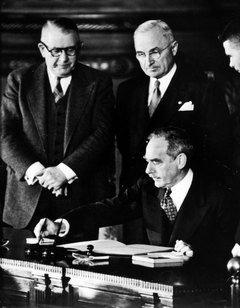
President Truman watch as Sec. of State Dean Acheson signs the North Atlantic Defense Treaty
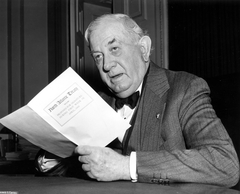
Photo of Senator Tom Connally (D), Texas, reading the text of the NATO Pact
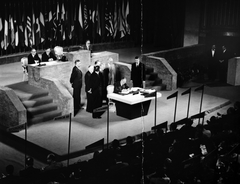
Secretary of State Dean Acheson Signing the Document During the Japanese Peace Treaty Conference
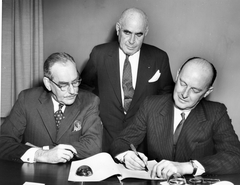
Canadian Ambassador Hume Wrong signs the Canadian Water Diversion Treaty at Washington
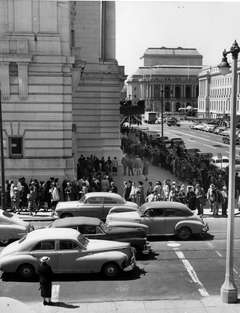
A Large Crowd Outside the San Francisco Opera House for Japanese Peace Treaty Conference
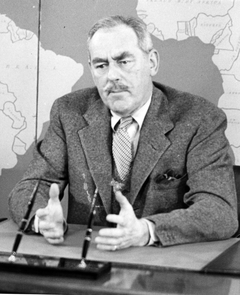
Secretary of State Dean Acheson Makes a Radio-TV Broadcast to the Nation from Washington
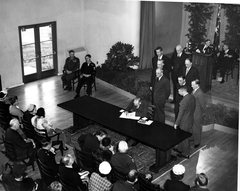
Dean Acheson Signs a Draft Tripartite Treaty among the United States, Australia, and New Zealand
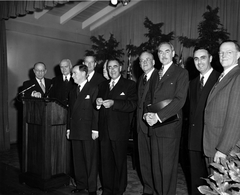
Dean Acheson and others at a conference relating to the draft tripartite treaty
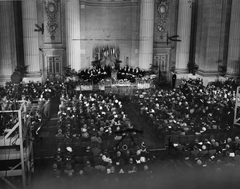
Opening ceremony of the signing of the North Atlantic Treaty Organization
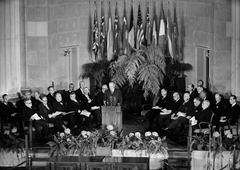
Dean Acheson speaks at opening of North Atlantic Treaty Organization signing ceremony
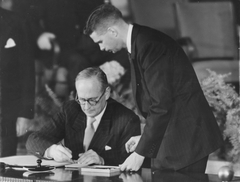
Halvard Lange signs North Atlantic Treaty for Norway as John W. Foley looks on
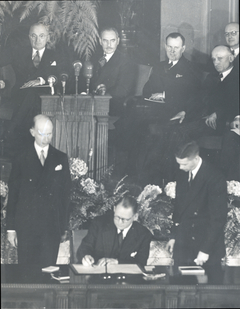
Dirk U. Stikker signs North Atlantic Treaty as Harry S. Truman and Dean Acheson look on
